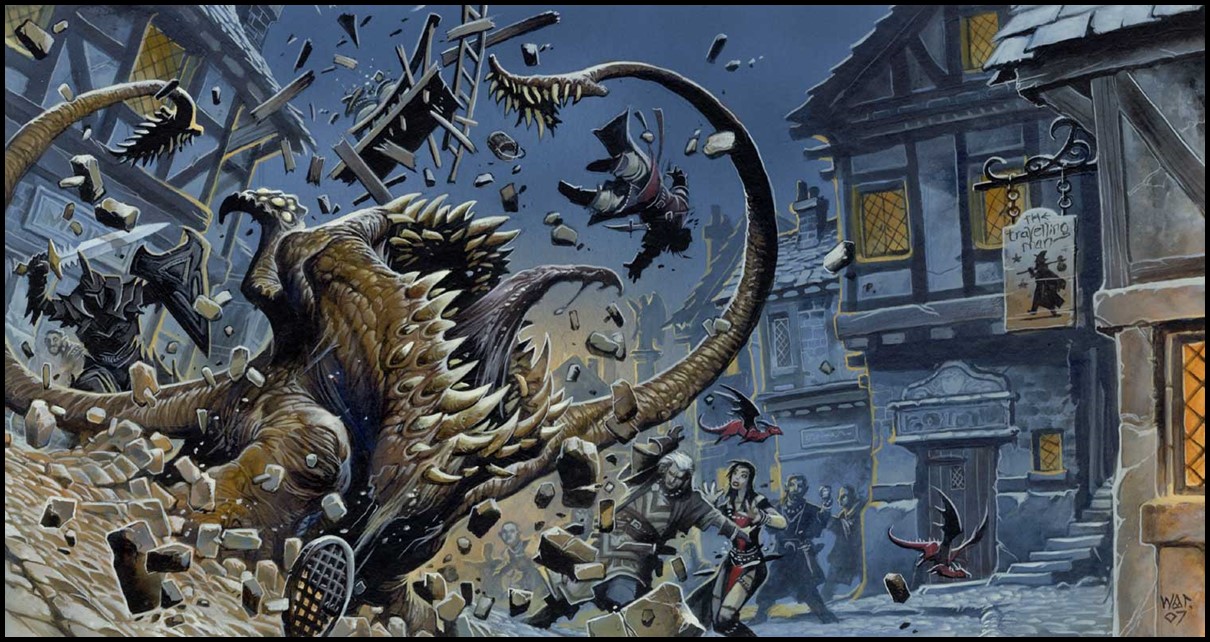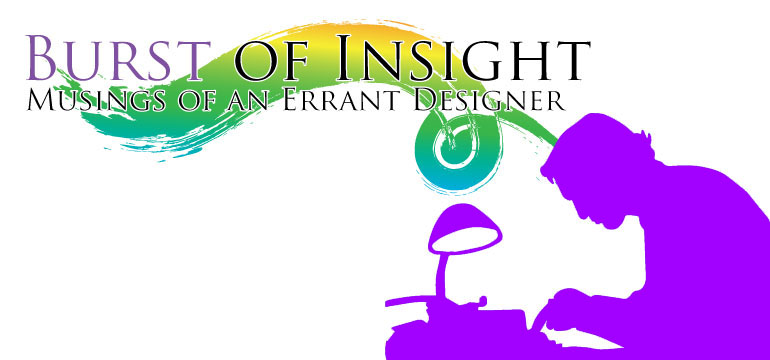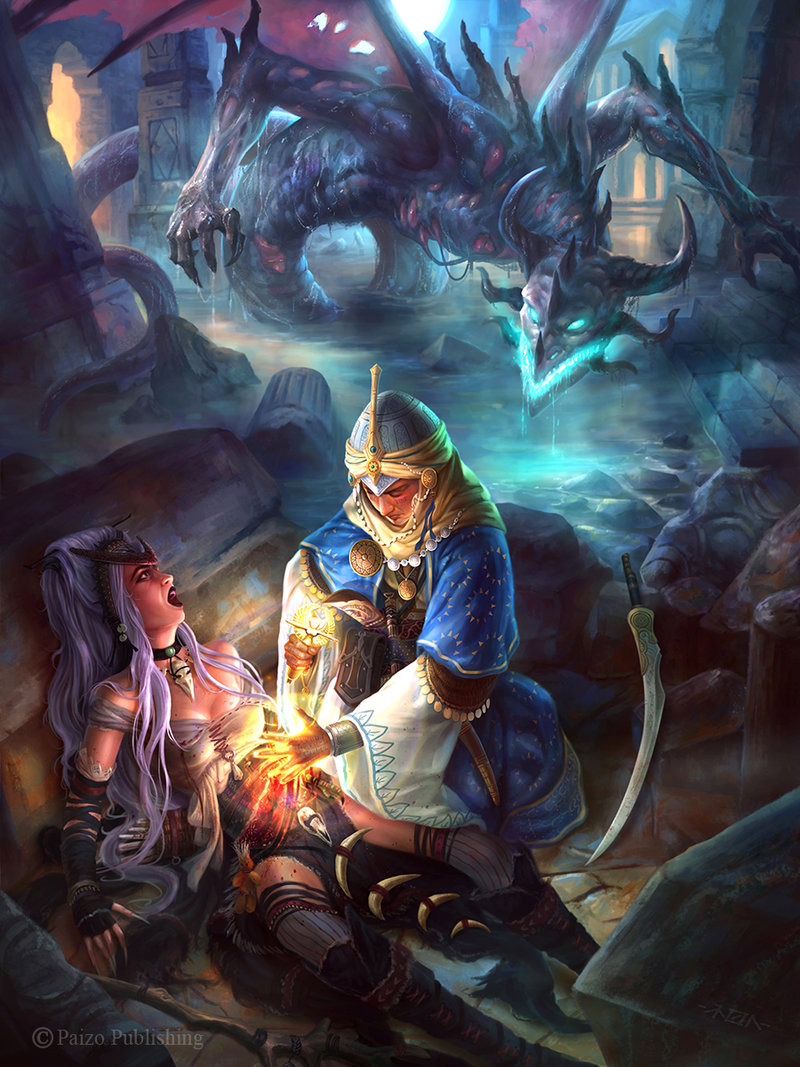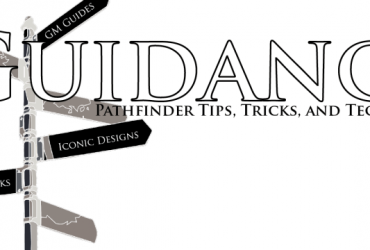Right now, I’m playing Pathfinder but not running a regular campaign. I am however, planning a new campaign and as a result house rules have been on my mind again but specifically, house rules involving hit points. In many of my 2e and 3e campaigns we’d start the campaign with 3rd or 5th level characters but lately in Pathfinder we’ve been starting at first level. The problem with starting level characters is they are fragile and the ten-minute adventuring day becomes a real problem. Now while I’d like more durable characters, raising the starting level affects more than I want at the moment. So, I’m looking at hit points today to see if there isn’t something we can do to buff up our PCs with out leveling up.

Copyright Paizo Inc.
Hit Points as a game mechanic have passed through edition after edition of Dungeons and Dragons and Pathfinder largely unchanged. It is still an abstract measure of how well your character or an NPC is endure several rounds of punishing combat. The more Hit Points your character has the better they are at shrugging off grievous injury and resisting death. Now while Pathfinder wizards and sorcerers get a few extra hit points the rule has not changed much from any of the game’s previous versions.

Cover images from Malhavoc Press, Wizards of the Coast, and Paizo Inc.
Now that isn’t to say that health and wounds have been handled the same in every d20 game. Looking over some of the other games to run on the d20 engine including the new Starfinder rules there have been a number of innovations and variant rules that alter how characters handle fights. Pathfinder’s Beta Playtest included a sidebar offering four variant rules for starting hit points including: One (that Starfinder players might find familiar) gave 1st level characters a racial hit point modifier and another option added a character’s full Constitution score. The d20 Star Wars Core Rulebook broke hit points into vitality and wound points a system that is a bit similar to the grace and health rules that appear in Monte Cook’s Collected Book of Experimental Might and the stamina and hit point rules from the Starfinder Core Rulebook. All of these rules make starting PCs a little hardier without eliminating interesting threats and dangers based mechanics like save DCs that adjust as you increase level.
Each of these systems made small changes to how the d20 engine runs combat. The variants in the Beta Playtest were the least complicated characters started with a few more hit points through one source or another. In Star Wars you didn’t multiply weapon damage on a critical hit but applied the normal damage directly to the target’s wound points. Vitality also doubled as a resource Jedi characters could use to power their Force abilities. Similarly, in the Experimental Might system grace points are also a spendable resource allowing character’s to push themselves to move farther and faster, improve certain physical skill rolls, and even recall spells you’ve expended. Starfinder brings us stamina points, hit points, and resolve points. Stamina like grace and vitality represents your energy and endurance while hit points are a measure of your physical wellbeing. Resolve is something new however more reminiscent of Pathfinder Unchained’s Stamina rule. Players may spend resolve points to regain stamina points (with a rest), stabilize when you are dying, or to stay in the fight while unconscious.
So, I’ve been considering all these options and thinking about how I’ll handle hit points in my next campaign. I really like how grace and vitality can be spent to pay for taking particularly taxing actions, but I think, I want actions to have a uniform cost. Basically, you can do these things and each costs x number of hp. I like this application because it adds another interesting risk-reward choice to actions characters may attempt in combat.
Magical Healing
Now while I have been considering these rules I just came across two things of related interest. One, is an article from Keith Baker he posted this past week about making divine magic more mysterious and dramatic. While the article is generally advice for narrative tweaks to divine magic it did get me thinking about the primary divine intervention in fantasy RPGs: magical healing. The other was a rediscovery in Experimental Might about divine healing. The latter is a rule that says clerics can heal an unlimited number of times per day but a recipient can only receive healing from magic a limited number of times per day. There is also a limitation on how many individuals the cleric can heal each day, but that number rises quickly as the character increases in level.
I have lots of options to consider so I think I may have an excuse to playtest a variant hit point rule in a short game to see how it works in the short term before adding it to my table long term.
House Rules
Stamina & Hit Points Playtest Version 1
Player Characters will get two health pools: Stamina and hit points, to borrow from Starfinder’s parlance. Stamina will be equal to the character’s normal Pathfinder hit points. Hit points on the other hand, will be equal to 10 + racial modifier + Con +1 per level.
Frail races (elves, gnomes, and halflings) get +4 hp, standard races (half-elf and human) get +6 hp, while the hardy races (dwarf and half-orc) get +8 hp.
When PCs are injured they lose points from thier Stamina first. Only when thier stamina pool is reduced to 0 do they begin losing hit points. Like with the grace and health rules the primary mechanical difference between the two pools is the rate of healing. For every 10 minutes of rest, you may heal your largest hit die + con modifier worth of stamina points. During an overnight rest, all of a character’s stamina points are restored and they regain 1 hp per day of rest. When magical healing is applied the character is healed of stamina damage first then hit point damage.
The Toughness feat adds to the character’s hit points normally while the Extra Stamina feat from Pathfinder Unchained adds to the character’s stamina points. Temporary hp such as from a barbarian rage are typically applied to the stamina pool unless noted otherwise in an update to these house rules.
Stamina points may be spent by to accomplish the following tricks.
- Anyone can spend 2 stamina points to move an Extra 5 feet as a part of a single move or double move once per round.
- Anyone can spend 5 stamina points to gain a +2 on a movement related skill check (such as acrobatics, climb, fly, or swim) or an unmodified physical ability check (such as a Strength check to break things).
- Anyone can spend 10 stamina points to take an extra move action (once per round)
- A character with the Combat Stamina feat from Pathfinder Unchained may spend thier stamina points as the feat describes and can also spend stamina to perform combat tricks for the combat feats they possess.
Characters who are fatigued, exhausted or unconscious cannot spend stamina points except to take it as damage.
If this works out well we’ll see about adding the magical healing rules from the Experimental Might book.







